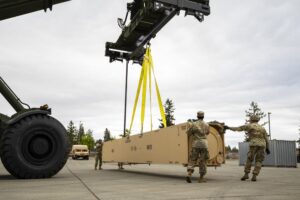A U.S. Army official this week outlined where the service sees specific opportunities to lower costs for parts of hypersonic missiles and highlightedlimitations in the current supply chain.
Dynetics [LDOS] has the Army contract to build the Common Hypersonic Glide Body (C-HGB) used by both the Army and Navy, which both services are integrating into their separate launching platforms. The Army aims to field their ground-based hypersonic weapon first, the Long Range Hypersonic Weapon (LRHW) by the end of this year.

Last month, the Army’s top acquisition official Doug Bush confirmed the first operational battery of the LRHW will be fielded by the end of the calendar year rather than the end of fiscal year 2023 (Defense Daily, Sept. 19).
Chris Mills, deputy director at the Army Hypersonics Project Office of the Rapid Capabilities and Critical Technologies Office, this week said he sees opportunities on the industry side “for improvements in internal components, as we try to improve the system going forward.”
That means they will have technology insertions with “specific capabilities that could improve the system as it goes forward,” Mills said during a Defense News event at the Association of the U.S. Army’s annual conference on October 9.
Mills said they especially foresee opportunities to lower costs in the parts with components that are already low cost and with the thermal protection system, pushing at “making that more producible and cheaper or less expensive and more affordable. That would be a focus area as well.”
Mills also outlined the challenges in hypersonic missile supply chains that are still “immature.”
He said DoD has put a “pretty sizeable amount of investment” into improving the supply chain, particularly in hypersonic materials to deal with high temperature heat and plasma issues.
However, Mills noted that “part of the problem with the hypersonic industrial base is we’re talking small quantities right now. So we’ve got to keep these companies that have that technology in business, and producing and leveraging that capability.”
Beyond hypersonic-specific industry immaturity, Mills said there is currently “huge demand” on the supply chain to ramp up all booster and missile technology across all DoD missile systems, which impacts hypersonic programs as well.

“There’s a huge demand on that supply chain right now, because we’re building missiles across the portfolio. And also that portfolio had almost a dip in production for a while, building missiles. And it’s almost like the, across the board, DOD in some areas, having to relearn how to design and build new missiles. And now we’re ramping up the supply chain with that.”
Mills said this also includes limitations on the supply chains common to other DoD systems and hypersonic weapons, including electronic components, alloys and forgings.
“Even stuff like forgings and alloys and stuff like that, there’s a big demand on forgings. Precision forgings. So that’s some of the challenges we have.”
A July DoD notice said a new Innovation Capability and Modernization (ICAM) team was looking to help address gaps in the technology and manufacturing supply chain for hypersonic weapons. The Department overall seeks to cut the estimated production costs of future hypersonic weapon capabilities by 30 to 80 percent (Defense Daily, Aug. 3).
The notice specifically said the ICAM team aims to improve hypersonic supply chain technologies, lower costs, increase manufacturing capacity and use disruptive technologies to help address production advancement gaps.
Last year, Undersecretary of Defense for Research and Engineering Heidi Shyu said she wants to make hypersonic weapon systems more affordable, which she said will be more achievable once the industrial base is more established (Defense Daily, Jan. 14 2022).